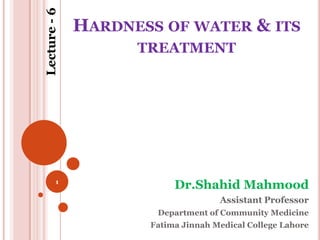
water hardness
- 1. Lecture - 6 HARDNESS OF WATER & ITS TREATMENT 1 Dr.Shahid Mahmood Assistant Professor Department of Community Medicine Fatima Jinnah Medical College Lahore
- 2. ACKNOWLEDGEMENTS Park K. Textbook of Preventive and Social Medicine Iliyas - Shah Public health and Community Medicine Maxcy- Rosenau-Last. Public health and Preventive Medicine o World Health Organization (WHO) o www.google.com/ images 2
- 3. SESSION PLAN Recap 1. Factors associated with water hardness 2. Methods how to treat hard water. 3. Hazards related to hardness of water 3
- 4. RECAP Q. Action of Chlorine for disinfection of water is maximum when water pH is around : A. 3.0 B. 5.0 Double pot method of well C. 7.0 disinfection D. 9.0 Answer : C 4
- 5. Q.2 Action of Chlorine for disinfection depends upon : A. pH B. Temperature C. Contact time D. All of the above Chloramines Free Residual Cl Answer : D Break point 5 Chlorine added
- 6. MODIFIED BRADLEY- FEACHEM CLASSIFICATION S# Types of diseases Features 1 Faeco -oral diseases Routes of transmission. Diarrhoel diseases , dysentry , hepatitis A 2 Water borne diseases Contamination of water by animal and human faeces, urine . Cholera, typhoid ,leptospirosis 3 Water washed diseases Scarcity and inaccessibility of water. Non-washing of hand, skin. Typhus, scabies, 4 Water based diseases Water provides habitat for intermediate host. Schistosomiasis, liver flukes, dracunculiasis 5 Water related vector Malaria, Filariasis, dengue , yellow fever , river diseases blindness [ mosquito and fly breeding sites in water] 6 6 Water dispersed diseases Legionella infection. Bacetria resides in air conditioning water system , fresh water amoeba
- 7. WATER RELATED NON- INFECTIOUS DISEASES S# Agents Diseases 1 Iodine Deficient in water Goiter , Hypothyroidism 2 Excess fluoride Dental Fluorosis 3 Fluoride Deficiency Dental Caries 4 Excess Inorganic salts Diarrhea 5 Cadmium Gastric upsets , Nephropathy 6 Sodium Hypertension 7 Sulfates Laxative effect 8 Nitrates and Nitrites Methaemoglobinemia 9 lead Lead poisoning 10 Arsenic Skin and lung diseases 7 11 Mercury Nephropathy
- 8. BOTTLED WATER Drinking water that is sold for human consumption in sanitary container. Plain bottled drinking water should not contain any sweetener, chemical additives. It should be calorie free and sugar free. Bottled water containing less than 250 PPM total dissolved solids is called ‘ Mineral Water’ 8
- 9. HARDNESS OF WATER Soap –destroying power of water Large quantities of soap or detergent required to produce foam /lather 9
- 10. ORIGIN OF HARDNESS - MECHANISM From Rocks & land , sediments 10
- 11. WHAT CAUSED THE HARDNESS OF WATER? Mainly due to Four Dissolved Compounds : 1. Calcium Bicarbonate 2. Magnesium Bicarbonate 3. Calcium Sulphate 4. Magnesium Sulphate Less Common: 1. Calcium Chlorides and Nitrates 2. Magnesium Chloride and Nitrates 3. Iron and Manganese salts 11 4. Aluminium Compounds
- 12. HOW HARDNESS CLASSIFIED? Hardness of water Non-Carbonate Carbonate Hardness hardness (Temporary Hardness) (Permanent Hardness) Calcium & Magnesium Calcium Sulphate Bicarbonates Magnesium Sulphate Calcium Nitrates Magnesium Nitrates Calcium and Magnesium Chlorides 12
- 13. MEASUREMENT OF HARDNESS Expressed as milli -equivalent per litre (m Eq/l) or mg/L 1 mEq /l of hardness = 50mg CaCO3 (50ppm) in one litre mEq/L 1 3 6 13
- 14. BAD THINGS ABOUT HARDNESS ( DISADVANTAGES) Consumes More soap and detergent - Financial loss. When water boiled , Carbonates precipitates , deposited in boiler , require more energy for heating: Industrial loss and boiler inefficiency , may explode Shorten the life of cloth fabrics Not suited for various industrial processes 14 Shorten life span of pipes (deposition and scaling of salts)
- 15. REMOVAL OF HARDNESS 1. Boiling Temporary Hardness 2. Addition of lime 3. Addition of sodium carbonates 4. Base exchange process Permanent 1. Addition of Sodium carbonate Hardness 2. Base exchange process 15
- 16. METHODS TO REMOVE HARDNESS Boiling : (Expensive , no large scale use) Ca (HCO3)2 Ca CO3 + H2O + CO2 Insoluble Precipitate Calcium carbonate o Addition of Lime Ca(OH)2 + Ca (HCO3)2 CaCO3 + H2O Lime 16
- 17. ADDITION OF SODIUM CARBONATE (SODA ASH) Removes both temporary and permanent hardness Na2 CO3 + Ca (HCO3)2 NaHCO3 + CaCO3 CaSO4 + Na2CO3 CaCO3 + Na2SO4 Base Exchange Process (large scale) 1. Sodium Permutit is used ( Na2Al2 Si2O H2O ) 2. Exchange Na ions for Ca and Mg ions 3. Ca and Mg Permutit is formed . 4. Removes 100% hardness 5. Some raw water is added to protect against corrosive 17 action of 100% soft water
- 18. Fluoridation & Defluoridation of water Is Naturally present in land Essential for dental and bone health Deficiency = dental caries Excess = Dental fluorosis ; Skeletal fluorosis 1 ppm is the optimum requirement in water Fluoridation = ++ Fluoride level fluoride level. Defluoridation is the process of removing excess fL. Using 18 Phosphate.
- 19. ASSIGNMENT WORD LIMIT : 250 WORDS SUBMIT AT 9.30 AM (28TH JAN -12) REWARD : ATTENDANCE HAND WRITTEN Write Short Answers of following questions: 1. Differentiate between Break point Chlorination and Super- chlorination 2. Name health hazards associated with using swimming pool. 3. Name Bacterial diseases related with drinking polluted water 4. Differentiate between shallow well and deep well 5. Name Hazards associated with surface water. 19
- 20. Thank you 20
